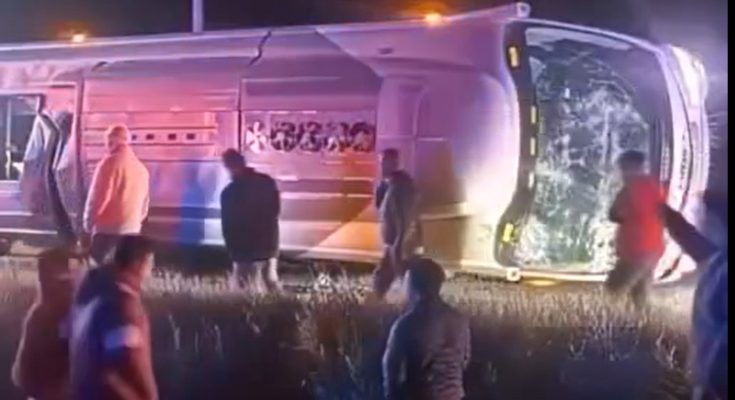A deadly highway collision in Huehuetoca, on the Mexico-Querétaro Highway, has left a nation reeling and investigators searching for answers. What began as a normal morning commute turned into a scene of devastation and disbelief, as a massive chain-reaction crash claimed 19 lives and injured dozens more. The question now haunting authorities is simple yet urgent: could this have been prevented?
The crash occurred at kilometer 059+000, near the town of Huehuetoca in the State of Mexico, on one of the country’s busiest transportation arteries. According to preliminary reports, the tragedy began when a heavy trailer failed to brake in time. Witnesses described the sound as deafening — the grinding shriek of tires followed by a thunderous impact that sent metal, glass, and debris flying across the asphalt. Within seconds, multiple vehicles were caught in the chaos, crushed, overturned, and piled up in a tangled mass of wreckage.
By the time emergency services arrived, the highway had become a disaster zone. The trailer had jackknifed across all three lanes, completely blocking northbound traffic. Drivers trapped in their cars screamed for help as smoke and dust filled the air. Some survivors managed to crawl free, disoriented and bloodied, while others could only watch in shock as flames began to lick the twisted remains of vehicles nearby.
Rescue workers raced against time to save anyone they could. Firefighters cut through mangled doors with hydraulic tools while paramedics worked to stabilize the injured on the roadside. Local hospitals were quickly overwhelmed, with ambulances ferrying victims for hours after the crash. Despite their efforts, the death toll climbed steadily as bodies were recovered from the scene.
Authorities later confirmed 19 fatalities — men, women, and at least one child. Many others were left seriously injured, their conditions ranging from broken bones to critical trauma. The emotional toll on families was immediate and crushing. Some arrived at the scene desperate for information, clutching phones and photographs, while others waited in hospital corridors through the night, hoping their loved ones would make it.
In the aftermath, investigators from multiple agencies began piecing together the sequence of events that led to the disaster. Their focus turned first to the trailer at the heart of the collision. Early evidence suggested that the vehicle’s braking system may have failed — but whether due to mechanical defect, lack of maintenance, or human error remains unclear.
The driver, who survived with injuries, is being questioned by authorities. Preliminary statements indicate he tried to slow down but lost control when his brakes didn’t respond. He reportedly shouted warnings over the radio moments before impact, but by then it was too late.
For investigators, the crash highlights a recurring and deeply troubling pattern: the persistent failure of safety enforcement on Mexico’s highways. Overloaded or poorly maintained freight vehicles are a familiar sight on the Mexico-Querétaro route, one of the country’s main commercial corridors linking the capital to industrial zones further north. Long-haul drivers often work punishing hours under immense pressure to deliver goods on time, sometimes sacrificing safety for speed.
Experts say these systemic issues create the conditions for tragedy. A single faulty brake line, a missed inspection, or a fatigued driver can turn a routine trip into a mass casualty event. And when it happens on a busy highway, the consequences are catastrophic.
Authorities from the State of Mexico’s transport and public safety departments have vowed a full investigation. Forensic teams are analyzing the wreckage to determine whether the trailer’s brakes failed due to mechanical fault or neglect. They’re also reviewing traffic camera footage and interviewing witnesses to reconstruct the timeline. Officials haven’t ruled out the possibility that multiple factors — including speed, load weight, and road conditions — contributed to the crash.
Meanwhile, public outrage is growing. Social media has been flooded with videos of the aftermath — burning vehicles, crying survivors, and first responders battling to contain the devastation. Many Mexicans are demanding tougher regulations for commercial trucking and stricter enforcement of safety standards.
“The government always promises action after tragedies like this,” one eyewitness told reporters, “but nothing changes. The roads are full of trucks that shouldn’t even be running.”
That sentiment is shared by many families now grieving loved ones lost in the crash. Several have already called for legal accountability — not only for the driver, but for the company that owned the trailer and the officials responsible for oversight. “This wasn’t an accident,” said one victim’s brother. “This was negligence. Someone let that truck on the road knowing it wasn’t safe.”
As the investigation unfolds, officials have temporarily restricted traffic on the affected section of the highway. Cleanup crews spent more than 12 hours removing debris and burnt vehicles from the scene. The highway was partially reopened the following day, but the scars — both physical and emotional — remain.
For the families of the dead, closure feels far away. Funerals are already being planned in Huehuetoca and neighboring towns. In one heartbreaking image circulating online, a child’s bicycle — retrieved from one of the cars — lies bent and charred among the rubble.
Road safety advocates say this tragedy should serve as a turning point. Statistics show that hundreds die each year on Mexican highways due to preventable crashes involving heavy trucks. Many of these deaths could be avoided with routine vehicle inspections, stricter compliance with rest hours for drivers, and better enforcement of weight and speed limits.
But change has been slow. Corruption, understaffed agencies, and weak penalties for violations have made meaningful reform difficult. And while transportation companies often pledge compliance, enforcement remains inconsistent.
The Mexico-Querétaro Highway has long been a symbol of both progress and peril — a vital artery for trade and travel, yet notorious for fatal collisions. The Huehuetoca crash is the latest and perhaps most sobering reminder of the cost of complacency.
As investigators continue their work, families wait for answers that may never come fast enough. The official cause may take weeks to confirm, but one thing is already clear: nineteen lives ended not because of fate, but because somewhere, someone failed to do their job.
Until that changes, the country’s highways will remain what they were that tragic morning — a dangerous intersection of negligence and inevitability, where an ordinary drive can turn deadly in seconds.



